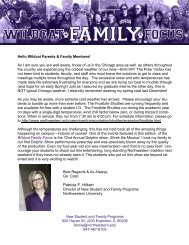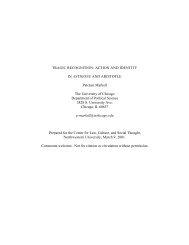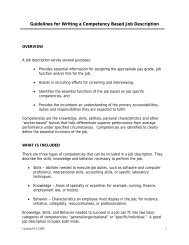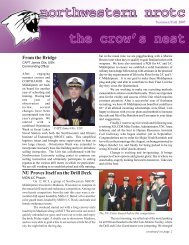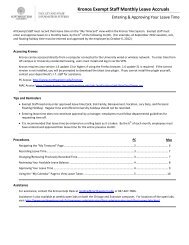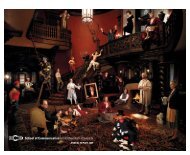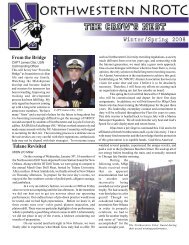Artistry Permits and Custom May Ordain - Northwestern University
Artistry Permits and Custom May Ordain - Northwestern University
Artistry Permits and Custom May Ordain - Northwestern University
Create successful ePaper yourself
Turn your PDF publications into a flip-book with our unique Google optimized e-Paper software.
12<br />
Comoros. 22 Such reconstructions have produced a picture of a remarkably unified realm of<br />
Swahili <strong>and</strong> Comorian speakers (<strong>and</strong> speakers of related dialects) comprising a far-flung<br />
<strong>and</strong> largely coastal linguistic community. While linguists have traced the movements of<br />
Swahili people as far south as northern Mozambique, the extreme southern<br />
coast—defined here as extending from Mozambique Isl<strong>and</strong> to just south of Sofala in the<br />
fifteenth century—has been largely excluded from linguistic analyses. 23<br />
The linguistic communality that characterized the East African coast from Barawa<br />
to Sofala in the fifteenth <strong>and</strong> sixteenth centuries until the middle of the seventeenth<br />
century is evident from contemporaneous written sources. 24 Portuguese sources are very<br />
clear that the language of the East African coast was not Arabic, though undoubtedly<br />
some Arabic speakers were in the region. Instead, coastal East Africans spoke what<br />
Europeans often referred to as the “language of the coast,” distinct from that of interior<br />
peoples <strong>and</strong> a “soft” language unlike the “harshness” of Arabic. 25 Thus Chittick’s<br />
assertion that a form of Swahili was spoken in the sixteenth century is probably accurate<br />
for much of the coast as well as the extreme southern maritime communities. 26 Suggestive<br />
of the relationship between the languages of the southern <strong>and</strong> central coasts—defined<br />
here as the area between the sultanates of Sofala <strong>and</strong> Malindi—the language of Zanzibar<br />
22 The most comprehensive studies include Hinnebusch <strong>and</strong> Nurse, Swahili <strong>and</strong> Sabaki: A Linguistic History.<br />
Berkeley, 1993; <strong>and</strong> D. Nurse <strong>and</strong> T. Spear, The Swahili.<br />
23 The extreme south has been neglected primarily because Swahili dialects are no longer spoken south of<br />
Mozambique Isl<strong>and</strong>. On languages of coastal northern Mozambique, see E. Rzewuski, Vocabulario da Lingua<br />
Mwani. Maputo, 1979; <strong>and</strong> A. Prata, “Análise Etno-Linguística do Xecado de Sangage,” Trabalhos de Arqueologia<br />
e Antropologia. 2 (1987): 26-37.<br />
24 Though Merka is often considered a Swahili city in the sixteenth century, V. Grottanelli’s “The Peopling of the<br />
Horn of Africa” (in East Africa <strong>and</strong> the Orient: Cultural Syntheses in Pre-Colonial Times. Eds. N. Chittick <strong>and</strong> R.<br />
Rotberg. New York, 1967. 44-75.) suggests that by the fifteenth century it was largely Somali-speaking.<br />
25 The Portuguese often termed the entire Swahili coast the “coast of Melinde,” since their connections to the<br />
city-state were so strong. Luiz Mariano, in discussing Malagasy at the turn of the seventeenth century, contrasts<br />
it with the language spoken on the East African coast. P. Luiz Mariano, “Exploração Portugueza de Madagascar.”<br />
cf. Manuel de Faria e Sousa’s mention of place names on the coast between Kirimba <strong>and</strong> Sofala. Asia Portuguesa.<br />
In Records. 1:22. Like other sources, de Figueroa noted that the language of the coast was “clearer than Arabic.”<br />
M. de Figueroa, Conquista de las Indias de Persia e Arabia que hizo la armada del rey don Manuel de Portugal. In A<br />
Spaniard in the Portuguese Indies. Ed. J. McKenna. Cambridge, 1967. 62. R. Gregson reviews the physiognomy<br />
of what the Portuguese called East African “Moors” in “Trade <strong>and</strong> Politics in South-East Africa,” 413-43. Briefly,<br />
the Portuguese distinguished between “white mouros” from the northern Indian Ocean <strong>and</strong> “dark” or “tawny<br />
mouros” (<strong>and</strong> in some cases simply “black”) on the East African coast. Indeed, Europeans often described the<br />
physiognomy of coastal Muslims in the same terms as non-Muslims of the southern African interior. J. Fryer, for<br />
example, described the Sultan of Nzwani, a “White Turbant” Muslim, as a ‘Wooly-pated Coffery.” A New Account<br />
of East India <strong>and</strong> Persia. Vol. 1. Ed. W. Crooke. London, 1909. 62.<br />
26 N. Chittick, “The East Coast, Madagascar <strong>and</strong> the Indian Ocean,” Cambridge History of Africa. Vol. 3. London,<br />
1977. 218-19. cf. G. Freeman-Grenville, “Medieval Evidences for Swahili,” Journal of the East African Swahili<br />
Committee. 29. 1959. 1-23; <strong>and</strong> Nurse <strong>and</strong> Spear, The Swahili, 49-51.



